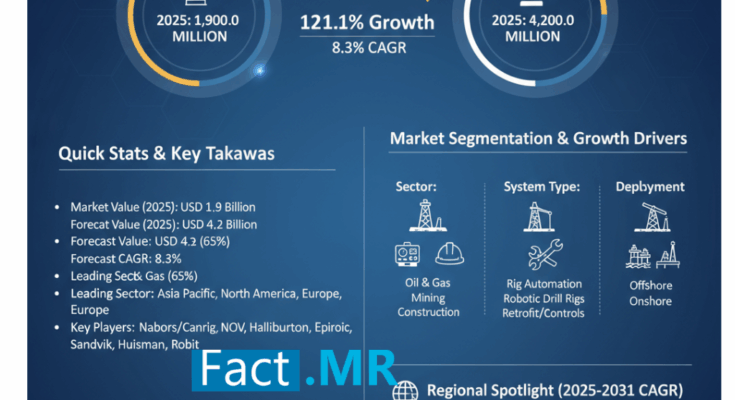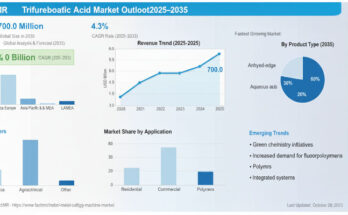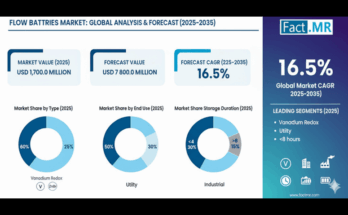The global robotic drilling market is on track for an era of rapid expansion, projected to grow from USD 1,900.0 million in 2025 to approximately USD 4,200.0 million by 2035, marking an impressive absolute increase of USD 2,300.0 million over the ten-year forecast period. This reflects a total growth of 121.1% and a compound annual growth rate (CAGR) of 8.3%, as industries worldwide accelerate their transition toward automation, safety optimization, and operational efficiency.
This expansion underscores a pivotal shift in how the global energy and mining sectors approach drilling operations. Automation, digital monitoring, and performance optimization are becoming the foundation of modern extraction strategies. Energy producers increasingly depend on robotic drilling systems to improve operational efficiency, reduce downtime, and ensure regulatory compliance in complex drilling environments.
Between 2025 and 2030, the robotic drilling market is expected to expand from USD 1,900.0 million to USD 2,850.0 million, reflecting a 41.3% rise in total market value. This phase of growth will be driven primarily by increased adoption of automated drilling systems in oil and gas applications, where efficiency and precision are paramount. As companies seek to reduce drilling costs while maintaining high production standards, robotic technologies are emerging as indispensable tools. From 2030 to 2035, the market will add another USD 1,350.0 million, contributing to 58.7% of the decade’s total growth. This second phase will be defined by the integration of cutting-edge robotics, AI-based control systems, and digital drilling management technologies designed to meet increasingly complex energy demands.
According to market analysts, robotic drilling is no longer a futuristic concept but a cornerstone of the energy industry’s transformation. Automation technologies are not only enhancing performance but also reducing the risks associated with manual operations, ensuring safer and more sustainable drilling practices across both offshore and onshore environments.
The oil and gas sector continues to lead the global robotic drilling landscape, accounting for around 65% of total market share in 2025. This sector’s dominance is driven by the rising need for comprehensive automation in energy workflows, where robotic systems provide a balance of performance, cost-efficiency, and safety. Energy operators are prioritizing robotic drilling solutions to manage high-precision extraction tasks, improve operational consistency, and comply with tightening environmental regulations. As energy companies modernize their extraction facilities, the integration of intelligent robotic systems has become central to maintaining competitiveness in global energy markets.
From a system perspective, rig automation represents the largest market segment, accounting for nearly 55% of total demand by 2025. These systems are at the core of automated drilling processes, offering advanced control, real-time data analytics, and performance optimization for complex drilling operations. Energy companies are adopting rig automation technologies to achieve consistent drilling results, improve energy utilization, and strengthen operational safety. The adoption of advanced automation systems also supports compliance with emerging energy performance standards and safety frameworks across leading energy markets.
Regionally, the Asia Pacific market is emerging as the fastest-growing region for robotic drilling, led by India and China. India is projected to record a CAGR of 10.2%, supported by government-led initiatives in energy modernization and the expansion of domestic drilling capabilities. Major energy hubs such as Mumbai, Chennai, and Ahmedabad are witnessing significant adoption of high-efficiency robotic drilling systems as companies invest in smarter, safer, and more productive drilling technologies. China follows closely with a CAGR of 9.2%, driven by its growing energy infrastructure, strong policy support, and rising awareness of automation’s role in performance optimization. Strategic investments in local manufacturing, supply chain resilience, and energy technology development are positioning China as a leading hub for robotic drilling innovation. Other high-growth markets include Mexico, South Korea, and Germany, each showing consistent progress in automation adoption and drilling modernization.
The robotic drilling market’s growth potential is further reinforced by multiple opportunity pathways. Oil and gas will continue to dominate, generating revenues between USD 1.2 billion and USD 2.7 billion as companies prioritize premium-grade drilling systems that enhance safety and reduce operational complexity. Rig automation systems will capture USD 1.0 to 2.3 billion in value, offering the best combination of cost-effectiveness and performance reliability. Emerging Asian markets, including India and China, represent an opportunity range of USD 450 to 850 million, while onshore premium drilling applications are expected to generate between USD 1.1 and 2.5 billion. Companies investing in advanced automation, digital integration, and supply chain reliability will be best positioned to capitalize on these opportunities, particularly in performance-sensitive energy and mining applications.
The competitive landscape of the robotic drilling market is defined by strong participation from established global players such as Nabors/Canrig, NOV, Schlumberger, Halliburton, Epiroc, Sandvik, Huisman, and Robit. These companies are actively investing in product innovation, strategic partnerships, and technology integration to enhance performance and reliability. The emphasis is on developing systems that combine automation with predictive analytics and remote operation capabilities, ensuring both efficiency and compliance with global energy safety standards. Players that offer superior supply chain management, comprehensive service support, and integrated digital solutions are likely to maintain competitive leadership through 2035.
Globally, the robotic drilling market is entering a data-driven decade where automation, digitalization, and intelligent systems will define the next phase of energy production. The convergence of artificial intelligence, machine learning, and automation is transforming drilling into a precise, efficient, and sustainable process. As energy producers align with global sustainability goals, robotic drilling technologies will play a vital role in achieving cleaner, safer, and more productive energy extraction.
Between 2025 and 2035, the robotic drilling market is expected to nearly double in value, positioning itself as a critical component of the modern energy ecosystem. With automation reshaping global energy operations, robotic drilling will not only redefine how energy is extracted but also set new standards for performance, safety, and efficiency in the evolving energy landscape.
Browse Full Report : https://www.factmr.com/report/robotic-drilling-market


